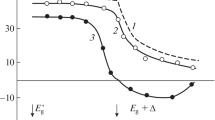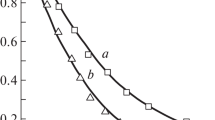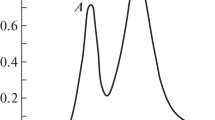It was shown recently [1, 2] that in semiconducting crystals it is possible to attain an appreciable orientation of the spins of the non-equilibrium carriers as a result of interband transitions caused by absorption of polarized light. Observation of optical orientation makes it possible to extend to semiconductors the research methods widely used in atomic spectroscopy [3], and particularly to investigate relaxation processes in a crystal under stationary conditions.
Similar content being viewed by others
Avoid common mistakes on your manuscript.
In the present investigation we used the method of optical orientation to measure the temperature dependence of the lifetime and the spin-relaxation time of the non-equilibrium electrons in the interval 77 to 300 K using mixed p-type GaxAl – xAs crystals, for which a strong electron orientation was obtained earlier [2] at 77 K.
The orientation of the non-equilibrium electrons was produced by predominant population of one of the conductivity subbands with m = 1/2 or –1/2, with the electrons excited by circularly polarized light (σ+ or σ–, respectively) from the valence band to the conduction band. The degree of stationary orientation of the electron spins (P) in the presence of relaxation is determined by the relation [1–3]
where T1 is the spin-relaxation time and τ is the lifetime of the non-equilibrium electron in the conduction band, P0 is the orientation in the absence of relaxation, determined by the probabilities of the transitions to the state with m = 1/2 or –1/2 upon absorption of circularly polarized light. In our case P0 = 0.5 for the interband transitions \(\Gamma _{{15.{\text{val}}}}^{{3/2}}\)–\(\Gamma _{{15.{\text{con}}}}^{{1/2}}\) [1, 2].
The times τ and T1 determine also the total lifetime of the oriented spin T1M:
which can be measured from the decrease of the degree of orientation of the electrons in a transverse magnetic field (a phenomenon analogous to the Hanle effect in atomic spectroscopy [3]). The dependence of the degree of orientation on the magnetic field intensity (H) has in this case a Lorentz form:
where ωL = eH/2mc is the frequency of the classical Larmor precession, and g is the spectroscopic factor of the electron. In the investigated GaxAl–xAs crystals we can assume g \( \simeq \) l [2].
Observation of the spin orientation of non-equilibrium electrons was based on the polarization of the conduction band–shallow acceptor recombination radiation. The connection between the degree of circular polarization of luminescence (S) and the degree of orientation of the spins was determined by the selection rules for the recombination transitions, and in this case S = 0.5P [2].
Thus, as follows from the presented relations, it is possible to determine the values of the lifetime τ and the spin relaxation time T1 of the non-equilibrium electrons from experimental measurements of the absolute value of S and the depolarization of the luminescence in a transverse magnetic field.
We measured S and T1M in Ga0.7Al0.3As crystals in the temperature interval 77 to 300 K. Figure 1 shows the dependence of the degree of polarization and luminescence on the magnetic field intensity at different temperatures. We see that the half-width of the polarization curve, which determines the time T1M (3), increases strongly with increasing temperature. The temperature dependence of the time T1M, obtained from these curves, is shown in Fig. 2, which shows also the measured dependence of the degree of polarization S (at H = 0) on the temperature. With increasing temperature, the degree of polarization drops from S = 0.21 ± 0.02 at 77 K to S = 0.03 ± 0.01 at 300°K. From the measured values of S and T1M we calculated the values of τ and T1 at different temperatures. These results are shown in Fig. 3. We see that the lifetime τ \( \simeq \) 10–10 s is practically independent of the temperature in the interval 77 to 300 K. On the other hand, the spin-relaxation time T1 in the same temperature interval decreases by a factor of approximately 60.
Temperature dependence of the lifetime τ and of the spin-relaxation time T1 on the non-equilibrium electrons, obtained from the data of Fig. 2.
The strong dependence of the spin-relaxation time on the temperature is a characteristic of the interaction between the spin and the lattice vibrations. For relaxation on acoustic oscillations at T < θD (θD is the Debye temperature) the theory predicts a power-law dependence of the relaxation time on the temperature: \(T_{1}^{{ - 1}}\) ~ (T K)5/2 [4]. It is seen from Fig. 3 that in the region 77 to 240 KFootnote 1 the observed T1 dependence agrees quite well with the T5/2 law. The deviation from this law in the region of higher temperatures is apparently due to the contribution of the optical oscillations, which cannot be neglected at these temperatures.
The lifetime τ changed insignificantly from τ = 0.9 × 10–10 s at 77 K to τ = 1.2 × 10–10 s at 300 K. However, the luminescence intensity decreased in this case by approximately one order of magnitude. A comparison of these facts makes it possible to conclude that in this case the lifetime of the electrons with respect to radiative transitions is at least 5–6 times larger than the total lifetime of the nonequilibrium carriers. The total lifetime is determined apparently by the nonradiative recombination via deep levels, and in this case, as is well known [6], it may remain constant when the temperature varies in a wide range. As shown by estimates, the increase of the radiative lifetime with increasing temperature may be due to a decrease in the number of neutral acceptors (Ei \( \simeq \) –0.03 eV) with which the nonradiative recombination takes place.
In conclusion, we note that our measurements of the total lifetime in conjunction with measurements of the quantum yield make it possible to determine the absolute value of the radiative lifetime.
Notes
From data on the IR spectra of the GaxAll – xAs crystals [5] we can estimate that θD \( \simeq \) 400 K for x = 0.7.
REFERENCES
R. R. Parsons, Phys. Rev. Lett. 23, 1152 (1969).
A. I. Ekimov and V. I. Safarov, JETP Lett. 12, 198 (1970).
C. Cohen-Tannoudji and A. Kastler, Prog. Opt. 5, 33 (1966).
S. T. Pavlov, Sov. Phys. Solid State 8, 719 (1966).
M. Ilegems and G. L. Pearson, Phys. Rev. B 1, 1576 (1970).
S. M. Ryvkin, Photoelectric Phenomena in Semiconductors (Fizmatgiz, Moscow, 1963; Springer, New York, 1964).
ACKNOWLEDGMENTS
We are grateful to Zh.I. Alferov for suggesting the problem and to V.I. Perel’, M.I. D’yakonov, and S.T. Pavlov for useful discussions.
Funding
This work was supported by ongoing institutional funding. No additional grants to carry out or direct this particular research were obtained.
Author information
Authors and Affiliations
Corresponding author
Ethics declarations
The authors of this work declare that they have no conflicts of interest.
Additional information
Publisher’s Note.
Pleiades Publishing remains neutral with regard to jurisdictional claims in published maps and institutional affiliations.
Rights and permissions
Open Access. This article is licensed under a Creative Commons Attribution 4.0 International License, which permits use, sharing, adaptation, distribution and reproduction in any medium or format, as long as you give appropriate credit to the original author(s) and the source, provide a link to the Creative Commons license, and indicate if changes were made. The images or other third party material in this article are included in the article’s Creative Commons license, unless indicated otherwise in a credit line to the material. If material is not included in the article’s Creative Commons license and your intended use is not permitted by statutory regulation or exceeds the permitted use, you will need to obtain permission directly from the copyright holder. To view a copy of this license, visit http://creativecommons.org/licenses/by/4.0/.
About this article
Cite this article
Garbuzov, D.Z., Ekimov, A.I. & Safarov, V.I. Measurement of the Lifetime and of the Spin-Relaxation Time of Electrons in Semiconductors by the Optical-Orientation Method. Jetp Lett. 118 (Suppl 1), S35–S37 (2023). https://doi.org/10.1134/S0021364023130106
Received:
Revised:
Accepted:
Published:
Issue Date:
DOI: https://doi.org/10.1134/S0021364023130106







